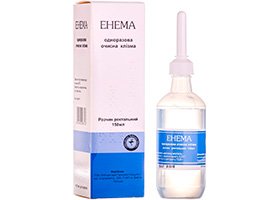
All iLive content is medically reviewed or fact checked to ensure as much factual accuracy as possible.
We have strict sourcing guidelines and only link to reputable media sites, academic research institutions and, whenever possible, medically peer reviewed studies. Note that the numbers in parentheses ([1], [2], etc.) are clickable links to these studies.
If you feel that any of our content is inaccurate, out-of-date, or otherwise questionable, please select it and press Ctrl + Enter.
Enema
Medical expert of the article
Last reviewed: 04.07.2025

Enema is an enema used to provide a laxative effect.
The combination of mono- and disodium phosphates with a small amount of plant glue forms a liquid whose pH level does not irritate the intestinal mucosa. The use of a hypertonic enema causes an influx of water into the intestinal lumen. After moistening, the softened fecal masses become larger in volume, leading to stretching of the colon walls, as a result of which defecation occurs after 5-20 minutes.
ATC classification
Active ingredients
Pharmacological group
Pharmachologic effect
Release form
The drug is released in the form of rectal liquid, inside 0.15 l bottles. There is 1 bottle in a pack.
 [ 3 ]
[ 3 ]
Dosing and administration
The medication must be administered rectally. The protective cap is removed from the bottle, after which its tip is inserted into the anus and the solution is carefully squeezed out. After the procedure, the patient must lie on his side or back until the urge to defecate appears.
To eliminate the symptoms of constipation, 1 enema is administered 5-20 minutes before the time chosen for bowel movement.
When preparing for an X-ray or endoscopy, 1 enema is administered in the evening, and then another 1 in the morning on the day of the procedure.
You can use a maximum of 1 enema per day.
Use Enemas during pregnancy
Treatment of constipation during pregnancy is permitted only in case of limited use of laxatives via enemas. For safer procedures, it is recommended to abandon phosphate enemas.
Enema can be used during breastfeeding and pregnancy only with the permission of a doctor.
Contraindications
Main contraindications:
- increased intolerance associated with elements of the drug;
- salt imbalance disorder accompanied by Na retention, as well as CHF;
- intestinal blockage;
- OPN;
- megacolon, anal fissures, active phase of hemorrhoids, and in addition, hemorrhagic rectocolitis;
- dehydration.
 [ 4 ], [ 5 ], [ 6 ], [ 7 ], [ 8 ], [ 9 ], [ 10 ], [ 11 ], [ 12 ]
[ 4 ], [ 5 ], [ 6 ], [ 7 ], [ 8 ], [ 9 ], [ 10 ], [ 11 ], [ 12 ]
Side effects Enemas
Occasionally, when using Enema, the following side effects appear:
- EBV disorders, including acidosis, hypocalcemia, hyperphosphatemia, and hypernatremic dehydration, which cause seizures. Such disorders may occur due to intoxication, the patient's early age, or the presence of aganglionosis in the child's colon, as well as due to renal insufficiency;
- Rectal application of sodium phosphate solution may cause local irritation or necrosis in the rectal area;
- allergy symptoms, with or without a rash.
Overdose
In case of accidental overdose, it is necessary to stimulate phosphate excretion, as well as to perform procedures that strengthen the patient's condition and correct acidosis and serum electrolyte levels (especially Ca).
Interactions with other drugs
It is prescribed with extreme caution to people who use diuretic drugs, substances that block the activity of Ca channels, lithium and other agents that can change electrolyte values, causing hypokalemia or -calcemia, as well as hyperphosphatemia, acidosis and hypernatremic dehydration.
Shelf life
Enema can be used within a 24-month period from the date of manufacture of the medicine.
Application for children
Enemas with a volume of 0.15 l are prohibited for use in pediatrics.
 [ 27 ]
[ 27 ]
Analogues
The analogs of the drug are Enema Klin and Normacol enema.
Manufacturer
Attention!
To simplify the perception of information, this instruction for use of the drug "Enema" translated and presented in a special form on the basis of the official instructions for medical use of the drug. Before use read the annotation that came directly to medicines.
Description provided for informational purposes and is not a guide to self-healing. The need for this drug, the purpose of the treatment regimen, methods and dose of the drug is determined solely by the attending physician. Self-medication is dangerous for your health.

